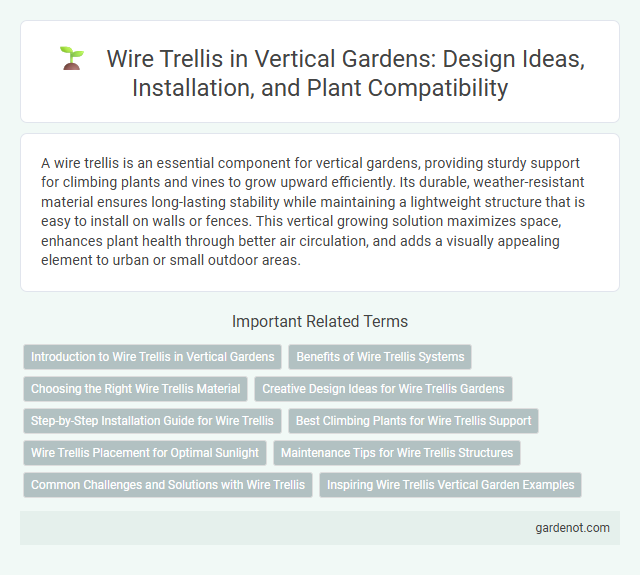A wire trellis is an essential component for vertical gardens, providing sturdy support for climbing plants and vines to grow upward efficiently. Its durable, weather-resistant material ensures long-lasting stability while maintaining a lightweight structure that is easy to install on walls or fences. This vertical growing solution maximizes space, enhances plant health through better air circulation, and adds a visually appealing element to urban or small outdoor areas.
Introduction to Wire Trellis in Vertical Gardens
Wire trellis systems offer a flexible and durable framework for vertical gardens, supporting climbing plants and maximizing green space in urban environments. Constructed from galvanized steel or stainless steel wire, these trellises provide resistance to weather and corrosion, ensuring long-lasting plant support. Efficient installation and low maintenance make wire trellises an ideal solution for vertical gardening on walls, fences, and balconies.
Benefits of Wire Trellis Systems
Wire trellis systems enhance vertical gardens by providing strong, flexible support for climbing plants, maximizing space efficiency in urban environments. Their durable construction ensures long-lasting stability and easy customization to fit various garden layouts. These systems also promote healthy plant growth by improving air circulation and sunlight exposure.
Choosing the Right Wire Trellis Material
Selecting the ideal wire trellis material is essential for a durable and supportive vertical garden structure. Galvanized steel offers excellent rust resistance, ensuring longevity in outdoor environments, while stainless steel provides superior strength and corrosion protection. For lighter plants, coated or vinyl-covered wire trellises prevent damage and enhance aesthetic appeal, making them a versatile choice for various vertical gardening needs.
Creative Design Ideas for Wire Trellis Gardens
Wire trellis gardens offer versatile support structures for climbing plants, enabling creative design ideas such as geometric patterns, spiral shapes, and personalized motifs to enhance vertical greenery. Incorporating wire trellises with mixed plant varieties like ivy, jasmine, or climbing roses creates dynamic textures and layers, maximizing aesthetic appeal in limited spaces. Effective placement and tension adjustments of the wire framework ensure sturdy growth and vibrant displays, transforming ordinary walls into living works of art.
Step-by-Step Installation Guide for Wire Trellis
Begin by measuring the desired wall area and cutting the wire trellis to fit using wire cutters, ensuring dimensions align with your vertical garden's design. Secure mounting brackets or eye hooks into the wall studs at consistent intervals using a drill and anchors to provide strong support for the trellis weight. Finally, stretch the wire trellis taut over the brackets, fastening it with zip ties or metal clips to create a stable framework for climbing plants or vines in your vertical garden.
Best Climbing Plants for Wire Trellis Support
Wire trellises provide an ideal framework for climbing plants like Clematis, Jasmine, and Honeysuckle, known for their vigorous growth and ability to entwine securely. These plants benefit from the sturdy support, allowing vertical expansion that maximizes garden space and enhances aesthetic appeal. Choosing varieties such as the Star Jasmine or Sweet Autumn Clematis ensures vibrant blooms and dense foliage, perfect for privacy screening and decorative purposes.
Wire Trellis Placement for Optimal Sunlight
Proper wire trellis placement is crucial for vertical gardens to maximize sunlight exposure, ensuring healthy plant growth and increased yield. Position wire trellises on south-facing walls or areas with unobstructed access to sunlight for at least six hours daily, promoting efficient photosynthesis. Spacing the trellis away from shading objects like trees or buildings further optimizes light capture and airflow.
Maintenance Tips for Wire Trellis Structures
Wire trellis structures for vertical gardens require regular inspection to ensure tension remains consistent and prevent sagging or warping over time. Cleaning the wire with a mild detergent and water helps avoid rust buildup and prolongs the lifespan of galvanized or stainless steel materials. Tightening connectors and treating any exposed metal with rust-resistant coatings are essential maintenance steps to sustain structural integrity and support plant growth effectively.
Common Challenges and Solutions with Wire Trellis
Wire trellises for vertical gardens often face challenges such as rusting, insufficient support for heavy plants, and installation difficulties on uneven surfaces. Using galvanized or stainless steel wire trellises can prevent rust and corrosion, while securing the trellis with strong anchors ensures stability for climbing plants like clematis or tomatoes. Customizable modular wire trellis systems help overcome installation issues by adapting to various wall textures and garden layouts.
Inspiring Wire Trellis Vertical Garden Examples
Wire trellis systems transform vertical gardens by providing sturdy support for climbing plants such as ivy, clematis, and jasmine, enhancing both aesthetics and space efficiency. Popular inspiring wire trellis designs include geometric patterns, grid layouts, and cascading vines that create living green walls ideal for balconies, patios, and urban spaces. Utilizing rust-resistant galvanized steel wire trellises increases durability, making them perfect for year-round outdoor vertical gardening solutions.
Wire trellis Infographic

 gardenot.com
gardenot.com